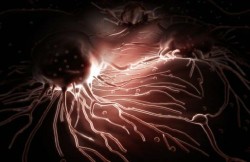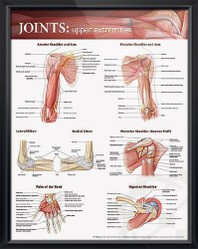Cause of Cancer
The cause of cancer is not known. All cells divide to produce other cells, and it is thought that the escape from normal controlling factors is due to a mutation, or change, occurring at the time of cell division. Cancer usually begins as a localized process.
At the start just a few, or perhaps even one, cell becomes an abnormal, or mutant, cell. The cancerous cell or cells grow quickly in number by dividing to produce daughter cells. The process of cell division, called mitosis, enables each cancer cell to produce two identical cells Which, in turn, produce four cancer cells. As replication continues, the cancer grows in size. The cause of such a mutation is not clear, and there may be many factors that can favor or initiate a mutation.
There are a great many substances, called carcinogens, which appear to be capable of causing or helping to cause the mutation that results in cancer. Among these are X rays and other sources of radioactivity and chemical compounds to which workers are exposed in certain occupations. Cigarette smoking is thought by many scientists to favor the development of lung cancer, and the excessive use of alcohol may increase the incidence of cancer of the throat. A wart or mole on the body repeatedly irritated by clothing or one on the face that is repeatedly cut while shaving may become malignant, or cancerous. The irritation of the skin by excessive exposure to sunlight or to ultraviolet rays has been thought sometimes to cause skin cancer.
Viruses are known to cause certain types of cancer in animals but have not been shown to be responsible for human cancer. Cancer is hereditary in some animals, and there is evidence that heredity plays an important role in some forms of cancer in human beings.
In different parts of the world certain types of cancer are predominant. For instance, cancer of the stomach is more common in Japan and Iceland than in many other parts of the world; a special type of cancer of the jaw is common among children in East Africa; cancer of the liver occurs commonly in parts of Asia and Africa; and cancer of the throat is frequent in China. It is not known definitely what factors in the environment cause these differences. However, nutritional, racial, and infectious elements are thought to be responsible in some cases. It appears cancer is not a simple disease but a group of diseases, and many factors may be involved in its cause.
 | Foods to Fight Cancer: Essential foods to help prevent cancer Detailing the key foods that have been medically shown to be beneficial in both preventing and fighting cancer, this is the must-have resource for anyone looking to get healthy ... |
 | Knockout: Interviews with Doctors Who Are Curing Cancer--And How to Prevent Getting It in the Fir... In Knockout, Suzanne Somers interviews doctors who are successfully using the most innovative cancer treatments—treatments that build up the body rather than tear it down. Somer... |
 | How To Avoid Cancer - Top 10 Natural & Scientifically Proven Ways To Help Prevent Cancer AMAZON BESTSELLER!Cancer is, by far, one of the most prevalent and widespread diseases that the world is facing today. Across the globe, more than 12 million people are affected... |
Detection and Diagnosis of Cancer
Since the cure of cancer depends on early treatment, early detection of the disease is essential. The American Cancer Society has widely publicized seven danger signals that might indicate cancer. If anyone of these symptoms develops one should promptly see his physician;
1. Unusual bleeding or discharge
2. A lump or thickening in the breast or elsewhere
3. A sore that does not heal
4. Change in bowel or bladder habits
5. Hoarseness or cough
6. Indigestion or difficulty in swallowing
7. Change in a wart or mole
Even without symptoms, periodic examination is desirable, because many kinds of cancer arise in areas which can be easily seen or felt by the examining physician. In addition to the simple physical examination, more specialized techniques of cancer detection have been developed and are becoming increasingly available. One of these is the Papanicolaou smear, in which a few cells are obtained from a body cavity for microscopic examination. This method, which is simple, painless, and inexpensive, has been widely and successfully used for the detection of cancer of the female reproductive organs and is being used in detecting other types of cancer.
The biopsy is another method commonly used when a suspicious area is observed. In this procedure, a small piece of tissue is removed surgically, usually with local anesthesia, for examination with a microscope.
Since cancer grows differently from normal tissue it is nearly always possible to identify a bit of tissue as cancer. Since cancer usually resembles the tissue from which it originated, it is often, though not always, possible to determine the organ in which it arose. Routine X rays of the chest and special X-ray examinations of organs causing symptoms are often helpful in establishing the presence of cancer. Blood counts can indicate the presence of leukemia, and special chemical studies of the blood are important in diagnosing special types of cancer, such as that arising in the prostate gland.
 | Cancer: Fight It with the Blood Type Diet (Eat Right for Your Type Health Library) Dr. Peter J. D'Adamo has forever changed the strategy for eating right to lose weight and achieving maximum health. Because he discovered what many already instinctively knew-th... |
 | The Cancer-Fighting Kitchen: Nourishing, Big-Flavor Recipes for Cancer Treatment and Recovery A Culinary Pharmacy in Your PantryThe Cancer-Fighting Kitchen features 150 science-based, nutrient-rich recipes that are easy to prepare and designed to give patients a much-nee... |
 | Cancer: 100 Ways to Fight This is an authoritative handbook of thoughtful advice, solutions, and motivation for everyone touched by cancer. We do not know how much cancer is beyond our control and how mu... |
You might also like
JointsJoints occur at the intersections of bones.
TraumaTrauma is a medical term...





 Your rash and itching problems may be Scabieson 03/10/2013
Your rash and itching problems may be Scabieson 03/10/2013
 Tickson 11/06/2011
Tickson 11/06/2011
 Vitamin Kon 10/10/2011
Vitamin Kon 10/10/2011
 Vitamin Eon 10/10/2011
Vitamin Eon 10/10/2011



Comments